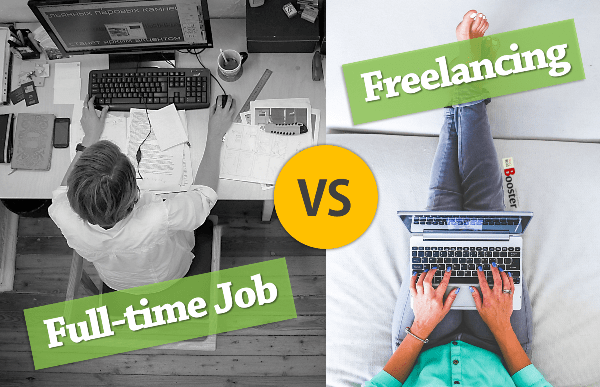Freelancing vs Full Time Jobs Which Career Path is Right for You
Compare freelancing vs full-time jobs in 2025. Discover salary differences, benefits, flexibility & career growth to choose your ideal path.

The modern employment landscape has transformed dramatically, with freelancing becoming a mainstream career choice rather than a temporary solution. As we move through 2025, 1.57 billion people are freelancers or somehow involved in freelancing out of the total workforce of 3.38 billion globally, representing a seismic shift in how we approach work and career development.
This evolution has created a critical decision point for professionals at every stage of their careers: should you pursue the flexibility and earning potential of freelancing, or embrace the stability and structured growth of full-time employment? The answer isn’t universal, as both paths offer distinct advantages that align with different personality types, life circumstances, and career objectives.
Recent market data reveals compelling trends that make this decision even more complex. 69% of employers surveyed hired freelancers after layoffs in 2023–2024, and over 99% plan to do so in 2025, indicating a fundamental shift in how businesses approach talent acquisition. Meanwhile, 58% of workers who haven’t freelanced are considering it for the future, suggesting growing interest in independent work arrangements.
The gig economy now contributes significantly to national economies, accounting for $1.3T and contributing 5% to the national GDP in the United States alone. This economic impact demonstrates that freelancing has evolved from a side hustle to a legitimate career path that can provide substantial financial rewards and professional fulfillment.
The nuances between freelancing vs full-time jobs require examining multiple factors beyond simple salary comparisons. Work-life balance, career advancement opportunities, financial security, and personal fulfillment all play crucial roles in determining which path aligns with your long-term goals. Whether you’re a recent graduate, mid-career professional, or someone considering a career transition, this comprehensive analysis will help you make an informed decision about your professional future.
The key to choosing between these career paths lies in honest self-assessment of your priorities, risk tolerance, and lifestyle preferences. Both freelancing and traditional employment can lead to successful, fulfilling careers when properly aligned with individual circumstances and objectives.
The Current State of Freelancing vs Full Time Jobs
Freelancing Market Overview
The freelance economy has experienced unprecedented growth, fundamentally reshaping the global workforce. Freelancers now represent 46.6% of the global workforce, a statistic that would have seemed impossible just a decade ago. This dramatic shift reflects changing attitudes toward work, technological advancement enabling remote work, and evolving business needs that favor flexible talent acquisition.
Digital transformation has been a key driver of this growth, enabling Freelancing vs Full Time Jobs to serve clients globally without geographical constraints. The rise of freelancing platforms, improved communication tools, and cloud-based collaboration software has eliminated many barriers that previously limited independent work. This infrastructure has created opportunities for freelancers to build sustainable businesses serving international clients while maintaining location independence.
The number of freelancers in the United States is expected to grow to 79.6 million by 2025 and to 90.1 million by 2028, indicating continued momentum in this sector. This growth spans across industries, from technology and creative services to consulting and professional services, demonstrating the versatility and broad appeal of freelance work.
Traditional Employment Evolution
Full-time employment has also evolved significantly, with many companies adopting more flexible policies and remote work options in response to changing workforce expectations. The traditional 9-to-5 office model is giving way to hybrid arrangements that offer some of the flexibility that makes Freelancing vs Full Time Jobs attractive while maintaining the stability and benefits of permanent positions.
Modern full-time jobs increasingly emphasize work-life balance, professional development, and employee wellness. Companies recognize that attracting and retaining top talent requires competitive benefits packages, career advancement opportunities, and flexible working arrangements. This evolution has made traditional employment more appealing to professionals who might otherwise consider freelancing.
The integration of technology has also transformed full-time work, with many positions now offering remote work options that provide location independence similar to freelancing. However, these arrangements still maintain the income stability and comprehensive benefits that characterize traditional employment.
Comprehensive Analysis: Freelancing vs Full Time Jobs

The Freedom of Freelance Work
Freelancing offers unparalleled professional autonomy, allowing individuals to design their careers according to personal preferences and life circumstances. This freedom extends beyond simple schedule flexibility to encompass complete control over project selection, client relationships, and professional development priorities. Freelancers can align their work with personal values, choosing projects that provide fulfillment beyond financial compensation.
The earning potential in freelancing often exceeds traditional employment, particularly for skilled professionals in high-demand fields. Experienced professionals often choose freelance work with multiple employers, leading to significantly higher profits compared to full-time employment with a single company. This potential stems from the ability to set competitive rates, serve multiple clients simultaneously, and scale services based on market demand.
Location independence represents another significant advantage, enabling freelancers to work from anywhere with internet connectivity. This flexibility eliminates commute time, reduces living costs in expensive metropolitan areas, and creates opportunities for travel while maintaining income. The ability to live in lower-cost areas while serving high-paying clients can significantly impact overall quality of life and financial well-being.
The diverse nature of freelance projects accelerates professional growth by exposing individuals to various industries, challenges, and technologies. This breadth of experience often makes freelancers more adaptable and innovative than their full-time counterparts, as they must continuously learn and evolve to remain competitive in the marketplace.
Navigating Freelancing vs Full Time Jobs Challenges
Income instability remains the most significant challenge facing freelancers, as earnings fluctuate based on client demand, project completion, and economic conditions. Freelancers get flexibility and independence but face income instability and no benefits, requiring careful financial planning and substantial emergency funds to manage irregular cash flow patterns.
The absence of employee benefits means freelancers must independently secure health insurance, disability coverage, and retirement planning. Full-time employees generally receive comprehensive packages from their employers, unlike freelancers, who are usually responsible for their own benefits, such as health insurance, retirement plans, and paid time off. These costs can be substantial and require careful budgeting to maintain adequate coverage.
Business management responsibilities consume significant time that could otherwise be spent on billable work. Freelancers must handle client acquisition, contract negotiation, invoicing, tax preparation, and administrative tasks, effectively reducing their hourly earnings. This entrepreneurial aspect appeals to some but can overwhelm individuals who prefer focusing solely on their core professional skills.
Professional isolation can impact mental health and career development, as freelancers miss out on daily interactions with colleagues and structured team environments. Building professional networks requires more intentional effort, and accessing mentorship or collaborative learning opportunities can be challenging without organizational structures.
Full-Time Employment: Benefits and Limitations
The Security of Traditional Employment
Full-time employment provides financial predictability through regular paychecks, enabling easier financial planning and goal setting. This stability extends beyond base salary to include comprehensive benefits that add substantial value to total compensation. Full-time employees often receive a comprehensive benefits package, including health insurance, retirement contributions, paid time off, and other perks that freelancers typically lack.
Career development opportunities are typically more structured in traditional employment, with companies investing in employee training, conferences, and skill development. These resources, combined with mentorship programs and clear advancement pathways, can accelerate professional growth and increase long-term earning potential. The collaborative environment of most organizations provides learning opportunities through team projects and knowledge sharing.
Job security offers peace of mind, particularly during economic uncertainty. Full-time employment is less dangerous because it offers stability through a steady wage and benefits package, compared to Freelancing vs Full Time Jobs, where economic downturns can immediately impact income. Legal protections, unemployment benefits, and severance packages provide safety nets that independent contractors must create independently.
The social aspects of traditional employment fulfill important human needs for connection and collaboration. Office environments foster relationships that often extend beyond work, creating support systems and professional networks that can benefit long-term career development.
Employment Constraints
Limited flexibility represents the primary drawback of full-time employment, with fixed schedules and policies that may not align with personal preferences or life circumstances. Traditional vacation approval processes, set working hours, and location requirements can restrict personal freedom and work-life balance.
Earning limitations in traditional employment are often constrained by salary bands, annual review cycles, and company budgets. Unlike freelancing, where rates can be adjusted per project or client, full-time employees typically have limited control over their immediate earning potential beyond seeking promotions or changing employers.
Corporate bureaucracy and office politics can stifle creativity and job satisfaction. Rigid policies, slow decision-making processes, and limited autonomy over work methods can frustrate individuals who prefer entrepreneurial environments or direct control over their professional activities. The time and cost associated with commuting, even with increasing remote work options, can significantly impact quality of life and overall compensation when factored into total work-related expenses.
Freelancing vs Full Time Jobs Comparison: Real Costs and Benefits

Analyzing Freelance Economics
Freelance income potential varies dramatically based on skills, experience, industry, and market positioning. Successful Freelancing vs Full Time Jobs in high-demand fields can earn significantly more than their full-time counterparts, with some charging premium rates for specialized expertise. The ability to serve multiple clients and diversify income streams provides opportunities for substantial earnings growth.
However, freelance earnings must account for additional expenses that Freelancing vs Full Time Jobs don’t face. Self-employment taxes, health insurance premiums, retirement contributions, professional development costs, and business expenses can consume 25-40% of gross income. Freelancers also don’t receive paid time off, requiring them to balance vacation time against lost income.
The feast-or-famine nature of freelance work requires careful financial management, including substantial emergency funds to weather periods of low client demand. Seasonal variations in business needs can create predictable income fluctuations that require long-term planning and budgeting strategies.
Evaluating Full-Time Compensation
Full-time salaries provide predictable income that enables easier financial planning and mortgage qualification. The total value of employee benefits often adds 20-30% to base compensation, including employer-contributed health insurance, retirement matching, and paid time off that represents significant financial value.
Career progression in traditional employment typically follows structured paths with regular salary increases through promotions, annual raises, and performance bonuses. While the immediate ceiling might be lower than top freelance rates, the long-term earning potential through career advancement can be substantial.
The job security of permanent positions provides stability during economic downturns, though layoffs remain possible. Unemployment benefits and severance packages offer some protection that independent contractors must create through personal savings and insurance policies.
Work-Life Balance and Lifestyle Considerations
Freelancing Lifestyle Dynamics
Freelancing offers maximum control over work scheduling, allowing professionals to optimize their productivity during peak hours and accommodate personal commitments. Freelancing vs Full Time Jobs. The elimination of commute time creates more opportunities for family, hobbies, and personal pursuits, potentially improving overall quality of life.
The ability to choose projects enables Freelancing vs Full Time Jobs to align work with personal interests and values, potentially increasing job satisfaction and motivation. This alignment can create a sense of purpose that enhances both professional performance and personal fulfillment.
However, work-life balance in freelancing requires strong self-discipline and boundary management. Without a clear separation between work and personal time, freelancers may find themselves working excessive hours or struggling to disconnect from professional responsibilities. People working independently have flexible schedules, but this flexibility requires careful management to avoid burnout.
Traditional Employment Structure
Full-time jobs provide clear boundaries between work and personal time, with defined schedules and company policies that protect personal time. Paid vacation, sick leave, and holidays ensure opportunities for rest without income loss, contributing to a better work-life balance for individuals who struggle with self-imposed boundaries.
Working in a structured environment can provide a sense of routine and stability that benefits individuals who thrive on predictability and clear expectations. The social aspects of office work fulfill important human needs for connection and collaboration. However, rigid schedules and policies may not accommodate personal circumstances or preferences, potentially creating stress for individuals with family responsibilities or non-traditional lifestyle preferences.
Industry-Specific Career Path Analysis
Technology and Digital Services Sector
The technology industry offers exceptional opportunities for both freelancing and full-time employment. Software developers, digital marketers, and data analysts can command premium rates as freelancers, benefiting from high demand and the naturally remote work nature of most tech roles.
Full-time tech positions provide access to cutting-edge projects, substantial resources, and collaborative environments that can accelerate skill development. Freelancing vs Full Time Jobs. The competitive salaries and comprehensive benefits in the tech industry make traditional employment particularly attractive for professionals seeking financial security and career advancement.
Creative and Design Industries
Creative professionals, including writers, designers, and content creators, often find freelancing particularly appealing due to creative freedom and project diversity. The ability to choose clients and projects that align with artistic vision can provide more fulfillment than working within corporate constraints. Full-time creative positions offer steady income and access to large budgets and resources, but may limit creative control and require work on projects that don’t align with personal interests or values.
Consulting and Professional Services
Management consultants, financial advisors, and other professional service providers can leverage their expertise effectively in both freelance and traditional employment settings. Freelancing allows for premium pricing and client selectivity, while full-time positions provide structure and resources for handling complex, long-term engagements.
Making Your Career Decision: Key Factors
Personal Assessment Framework
Your decision between freelancing vs Full Time Jobs should begin with an honest self-assessment of your personality, preferences, and circumstances. Consider your comfort level with uncertainty, need for social interaction, and preference for structure versus autonomy. Freelancing vs Full Time Jobs: Individuals who thrive on variety and independence may find freelancing more fulfilling, while those who prefer predictability and collaboration may benefit from traditional employment.
Financial circumstances play a crucial role in this decision. Freelancing requires substantial emergency funds and the ability to manage irregular income, while Freelancing vs full-time jobs provides immediate financial stability. Consider your current savings, family obligations, and risk tolerance when evaluating these options.
Long-Term Career Planning
Evaluate how each path aligns with your long-term career goals and aspirations. Freelancing provides entrepreneurial experience and unlimited earning potential, but may lack structured advancement opportunities. Full-time employment offers clear progression paths and professional development resources, but may limit immediate earning potential.
Consider the skills you want to develop and how each environment supports your learning objectives. Freelancing vs full-time jobs exposes you to diverse challenges and industries, while traditional employment provides deep expertise development and collaborative learning opportunities.
Emerging Trends and Future Outlook
Hybrid Work Models
The future of work increasingly features hybrid models that combine elements of both Freelancing vs Full full-time jobs and traditional employment. Many professionals now maintain full-time positions while pursuing freelance projects on the side, creating diversified income streams and expanded skill sets.
Companies are also adopting more flexible arrangements, offering contract-to-hire positions, project-based work within traditional structures, and increased remote work options that provide some freelance-like flexibility while maintaining employment benefits.
Market Predictions
In 2025, being a digital nomad is no longer about choosing between a job and freedom—it’s about designing your own version of both Freelancing vs Full full-time jobs. This evolution suggests that the rigid distinction between freelancing and full-time employment may continue to blur as both models adapt to changing workforce expectations.
The continued growth of the gig economy and increasing acceptance of remote work indicate that career paths may become more fluid, Freelancing vs Full Time Jobs with professionals moving between different employment models throughout their careers based on changing circumstances and opportunities.
Also Read: How to Find Freelance Clients Online for Beginners: The Ultimate Guide
Conclusion
The choice between freelancing vs full-time jobs ultimately depends on your individual priorities, circumstances, and career objectives rather than a universally correct answer. Freelancing offers flexibility, earning potential, and entrepreneurial opportunities but requires self-discipline, financial planning, and business management skills.
Full-time employment provides stability, comprehensive benefits, and structured advancement, but may limit autonomy and immediate earning potential. Success in either path requires commitment, continuous learning, and adaptation to evolving market conditions.
Consider your risk tolerance, financial situation, career goals, and lifestyle preferences when making this decision, remembering that modern career paths are increasingly flexible and can evolve as your circumstances change throughout your professional journey Freelancing vs Full Time Jobs.





